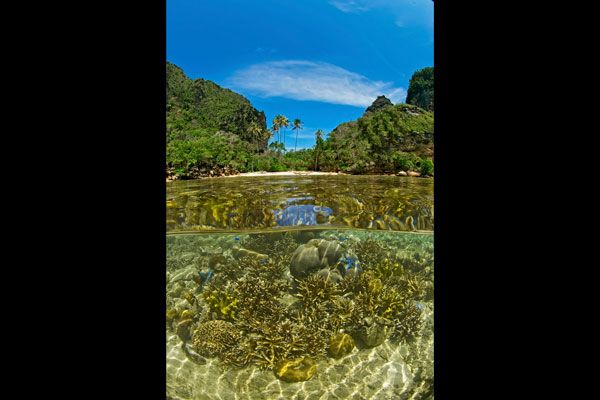By Maurine Shimlock and Burt Jones
For the Sequim Gazette
At dawn on the last day of the Balinese calendar 2007, while we sipped tea on the dew-soaked wooden deck of our chartered phinisi (a traditional Indonesian sailing vessel), the crew performed rituals in preparation for Nyepi, the day of silence that accompanies every new year. Fifteen hundred miles east of that fabled island, we watched the Balinese men who sailed our ship chant to their gods while we prayed silently to the weather gods for a smooth journey through this maze of coral reefs and limestone islands.
We were all far from home and together we had been charged with exploring an undersea wilderness so remote and so vast that a new name had to be created for it: Seascape, our planet’s largest. Our problem was much like Alice’s as she pondered how to navigate Wonderland: We wondered which way to go, where to begin? Then, just as the sky began to color, we watched a manta ray’s fin ripple the water’s calm surface and took it as a sign that we should dive close by. Following our instincts, we slipped beneath the surface of the most amazing sea we had ever encountered.
Unlike most Traveler’s Journal presenters, we travel professionally and our main work takes us far from our new home in Sequim. From Mexico to Indonesia via the Solomon Islands and Borneo, 37 years of travel to remote reefs has fueled our passion for the marine world and taught us about the connections we have to each other and to the environment we share.
Even though “sustainable marine tourism consultants” may not sound like a “real” job, it is. We often spend months at a time on small, smelly, creaky boats that barely stay afloat.
In the water for hours, diving until we are cold and hungry, by the end of our night dive we’re usually too exhausted to write up the day’s work or even eat dinner.
Currently we travel mainly to Indonesia’s Bird’s Head Seascape in West Papua to photograph and dive among the planet’s most bio-diverse reef systems. With more than 1,700 species of fish from 40-foot-long whale sharks, the largest, to coral gobies so tiny you’d never see them if they didn’t move, this far flung region of Indonesia is now on any diver’s must see list.
The evolution of this undersea wilderness into a very successful model for sustainable marine tourism development parallels our own passage from ardent spear fishermen to passionate conservationists; reluctant dive shop owners to award-winning photojournalists.
About the presenters:
Burt Jones and Maurine Shimlock are award-winning photojournalists who specialize in documenting tropical marine life and pioneering remote dive destinations.
Since 1992, they have explored the Indonesian archipelago and recorded images of its spectacular reefs. In 2002 they began working with the Indonesian branches of several NGOs, including Conservation International, to educate the world about Indonesia’s reefs and the urgent need to conserve them. They have published two popular guidebooks to the world’s richest reefs, “Diving Indonesia’s Raja Ampat” and “Diving Indonesia’s Bird’s Head Seascape,” which have promoted sustainable marine tourism as a way of preserving these regions’ unsurpassed marine life.
Their photography has been featured on the covers of more than a dozen of the world’s most prestigious publications, including GEO, BBC Wildlife, Smithsonian and Natural History. “Secret Sea,” the first large format collection of their photography, has won several publishing awards including the Benny Award for best photography book.
In 2012, Shimlock was inducted into the Women’s Diving Hall of Fame and honored for her photojournalism and conservation work. Committed to marine conservation, Jones and Shimlock use the art of photography to help preserve life in the sea.
About the presentations:
Traveler’s Journal is a presentation of the Peninsula Trails Coalition.
All of the money raised is used to buy project supplies and food for volunteers working on Olympic Discovery Trail projects.
Shows are at 7 p.m. each Thursday in February and March in the Sequim High School cafeteria at 601 N. Sequim Ave.
Cafeteria benches are hard and people are encouraged to bring cushions.
Suggested donation is $5 for adults. Youths 18 and younger are welcome and admitted at no charge.
Rainshadow Coffee Company provides free coffee.
One selected photo enlargement or prize is given away each week.
Creative Framing is donating the matting and shrink-wrapping of the photo door prize.
Call Dave Shreffler at 683-1734 for more information.



